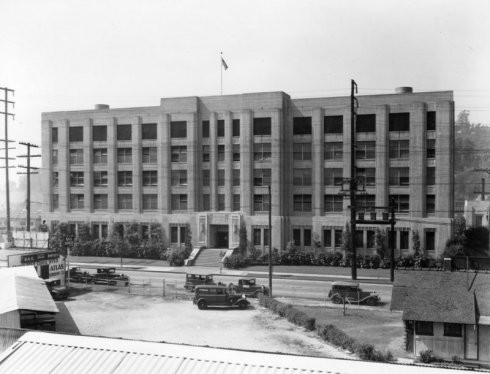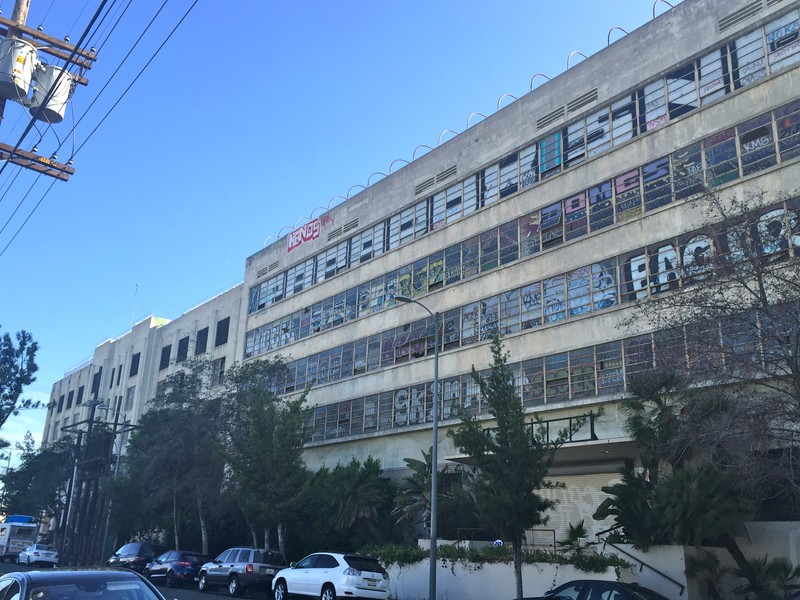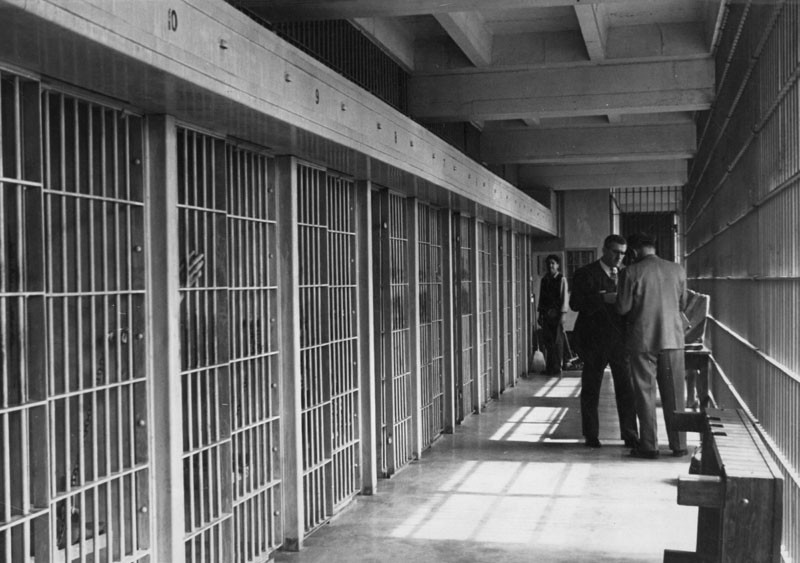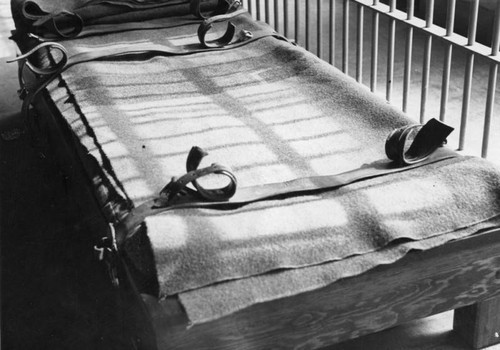Lincoln Heights Jail (1931-1965)
Introduction
Text-to-speech Audio
Images
Lincoln Heights Jail (1936)

Lincoln Heights Jail in 2015

Solitary confinement wing of Lincoln Heights Jail

Cot with leather straps to restrain prisoners in the solitary confinement wing of Lincoln Heights Jail

Backstory and Context
Text-to-speech Audio
Developed during the early 1900s, this site was originally the location of the East Side Police Station and its adjoining city jail. The building was one of three small police stations and jailhouses erected in the Los Angeles area during the period of substantial population growth for the city. By the 1920s, population growth had led to overcrowding in the jail. In the mid-1920s, a ballot measure was introduced to raze the police station and jail and construct a new jail building. The measure passed and in 1927 construction began on the Lincoln Heights Jail.
The $5 million, five-story building was designed in the Art Deco style by notable American architects Jesse E. Stanton and Gordon B. Kauffman- the latter of whom was the head architect behind construction of both the Hoover Dam and the Los Angeles Times building. When the Lincoln Heights Jail opened in 1931, it had room for 750 male inmates and 150 women. It was among the first of California's jails to use a 24-hour court system model to mitigate overcrowding.
Beginning in the 1940s, the Lincoln Heights Jail became notorious for its opening of large wing exclusively dedicated to the incarceration of homosexuals, drag queens, and transgender people. Derogatorily dubbed "The Fruit Tank" by prison guards and LAPD officers, the jail's large population of LGBTQ inmates was indicative of the broad crackdown on "sex crimes" initiated by LAPD Chief William Parker during these years. Undercover LAPD officers frequently engaged in a tactic known as "entrapment" in which they would visit gay cruising areas and lure individuals into arrests under the guise of initiating hookups. They would also often raid LGBTQ enclaves and arrest drag queens or transgender people for the crime of "impersonation" and "masquerading" (wearing clothes of the sex opposite to what was on their IDs).
Lincoln Heights Jail was also known for its sizable "drunk tank", where overly intoxicated Los Angeles partygoers were detained after being picked up for disorderly conduct. Among those who stayed at Lincoln Heights' drunk tank were Oscar-award-winning actress Lucile Watson and detective fiction writer Raymond Chandler. The jail also held famous criminals such as Al Capone, who was briefly imprisoned here on his downfall charges of tax evasion prior to being moved to the recently-opened Alcatraz Federal Penitentiary in 1934. The jail also played a prominent role during the Zoot Suit Riots of 1943, when white servicemen and LA residents began attacking young Latino and Black men wearing "zoot suits"- a popular style with Latino men during the 1940s. Over 500 minority men were arrested and held at Lincoln Heights Jail, an event that led to national condemnation and even a critical comment by First Lady Eleanor Roosevelt who pointed out that the events that led to the so-called riot were related to the state of American race relations. As was commonplace with racially motivated riots during this era, none of the white servicemen or residents who initiated or participated in the violence were arrested.
Sanitation and overcrowding again became an issue by the late 1940s. A large expansion project was undertaken in 1949 and completed two years later. The expanded Lincoln Heights Jail was capable of holding up to 4,000 inmates, although it typically held only about half of its capacity during its tenure. On December 25th of 1951, the new Lincoln Heights became the location of one of the most famous police brutality cases in Los Angeles history. Given the name "Bloody Christmas" by newspapers, seven young prisoners at Lincoln Heights were removed from their cells and brutally beaten for 95 minutes by a mob of 50 LAPD officers. The assaults were so severe and well-documented that the case was taken to court. This resulted in the first grand jury indictments of LAPD officers in Los Angeles history, as well as the first criminal convictions brought against the LAPD for use of excessive force. The incidents were later fictionalized in popular 1990 novel L.A. Confidential, as well as a Hollywood film adaptation which was released 7 years later.
In August of 1965, an altercation between LAPD officers and a young Black man who was pulled over for drunk driving led to five days of rioting after a rumor was spread that a pregnant woman was hit by a police officer. The Watts Riots lasted for five days, and resulted in 34 deaths and 3,438 arrests. Many of the arrests made during the riots were incarcerated at Lincoln Heights. The same year, after a review of the budget, the City of Los Angeles decommissioned the Lincoln Heights Jail and consolidated its prisoner population with the nearby Los Angeles County Jail.
The building was occupied by the Bilingual Foundation of the Arts from 1979 until 2014. A gym also operated out of the building's basement until 1994, when the owner of the gym fell down an elevator shaft on the property and died. Multiple scenes from Hollywood movies were filmed at the former Lincoln Heights Jail including the famous boiler room portions of Nightmare on Elm Street, as well as the prison sequences for both American History X and L.A. Confidential. In 2016, the City of Los Angeles submitted a request for restoration and development of the building- which was designated as a Los Angeles Historic-Cultural Monument on November 30, 1993. A year later, a local developer was chosen to create the 'Lincoln Heights Makers District', an eco-friendly public and commercial complex. As of March 2020, the project was delayed by conditions related to the global pandemic.
Cite This Entry
Admin, Clio and Elijah Bowen. "Lincoln Heights Jail (1931-1965)." Clio: Your Guide to History. December 8, 2020. Accessed March 27, 2025. https://theclio.com/tour/1638/5
Sources
AECOM; Hollins, Jeremy; Mello, Monica; Kry, Linda. CULTURAL RESOURCES ASSESSMENT FOR THE LINCOLN HEIGHTS JAIL LOS ANGELES, CALIFORNIA, City of Los Angeles Bureau of Engineering. September 2016. Accessed November 13th 2020. http://www.bidnet.com/bneattachments?/438947843.pdf.
Anderton, Frances. LA's historic Lincoln Heights Jail to be repurposed, KCRW. November 1st 2017. Accessed November 13th 2020. https://www.kcrw.com/culture/shows/design-and-architecture/las-historic-lincoln-heights-jail-to-be-repurposed.
LA Conservancy. Lincoln Heights Jail, LA Conservancy. Accessed November 13th 2020. https://www.laconservancy.org/locations/lincoln-heights-jail.
Rasmussen, Cecilia. Pasadena’s Gold Line Will Travel a History-Laden Route, Los Angeles Times. July 13th 2003. Accessed November 13th 2020. https://www.latimes.com/archives/la-xpm-2003-jul-13-me-then13-story.html.
https://www.laconservancy.org/locations/lincoln-heights-jail
https://www.laconservancy.org/locations/lincoln-heights-jail
https://www.laconservancy.org/locations/lincoln-heights-jail
https://www.laconservancy.org/locations/lincoln-heights-jail

